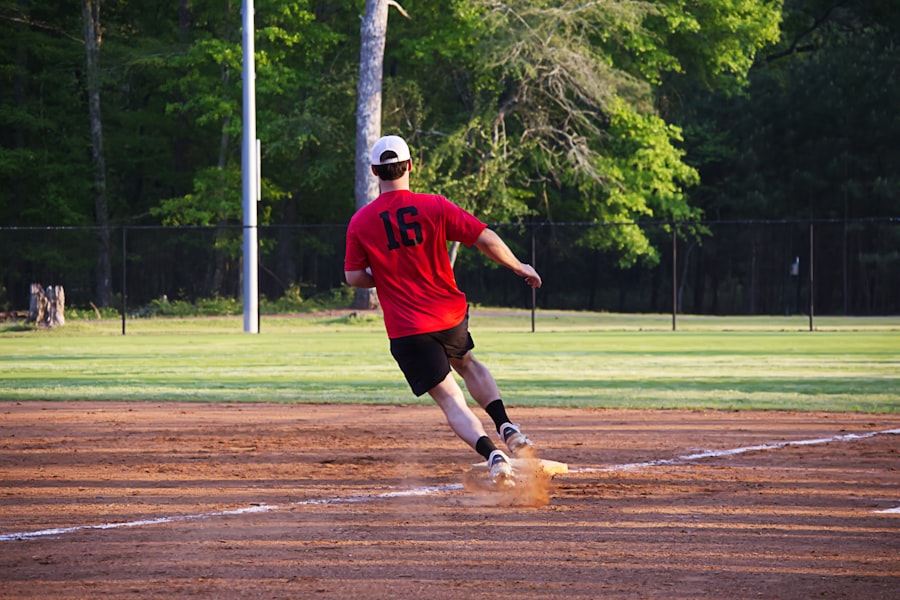Download links
How to install Mastering the Art of Softball: Tips for Success APK?
1. Tap the downloaded Mastering the Art of Softball: Tips for Success APK file.
2. Touch install.
3. Follow the steps on the screen.
Description
Softball is a bat-and-ball sport that shares many similarities with baseball but has its own unique set of rules and gameplay dynamics. Originating in the late 19th century, softball has evolved into a popular sport played at various levels, from recreational leagues to professional competitions. The game is typically played on a diamond-shaped field, featuring four bases arranged in a square.
The objective is to score runs by hitting the ball and successfully reaching home plate. Unlike baseball, which uses a hard ball, softball employs a larger, softer ball, which can influence the way players approach hitting and fielding. The game is played between two teams, each consisting of nine to ten players, depending on the specific variant of softball being played—fastpitch or slowpitch.
Fastpitch softball is characterized by a windmill pitching style and generally features a higher level of competition, while slowpitch involves a more leisurely pace and a different pitching technique. Understanding the basic rules, such as the number of outs per inning, the concept of strikes and balls, and the importance of base running, is crucial for anyone looking to engage with the sport. Additionally, players must familiarize themselves with the dimensions of the field, which can vary based on age groups and levels of play.
Key Takeaways
- Softball is a team sport similar to baseball, played with a larger ball on a smaller field.
- Essential skills for success in softball include throwing, catching, hitting, and base running.
- Mastering the fundamentals of hitting involves proper stance, grip, and swing mechanics.
- Improving fielding and throwing techniques requires focus on footwork, glove positioning, and arm strength.
- Enhancing pitching and catching abilities involves mastering different pitches and developing strong communication between pitcher and catcher.
Developing Essential Skills for Success
To excel in softball, players must cultivate a diverse set of skills that encompass both physical abilities and strategic thinking. Fundamental skills such as hitting, fielding, throwing, and base running form the foundation of a player’s performance on the field. Each skill requires dedicated practice and an understanding of the mechanics involved.
For instance, hitting involves not only the physical act of swinging a bat but also the mental acuity to read pitches and anticipate their trajectory. Players must develop hand-eye coordination and timing to make solid contact with the ball. In addition to physical skills, players must also focus on their mental game.
This includes understanding game situations, making quick decisions under pressure, and maintaining focus throughout the game. Coaches often emphasize the importance of situational awareness—knowing when to advance on the bases or when to hold back can be the difference between scoring runs or getting thrown out. Furthermore, players should engage in regular drills that simulate game scenarios to enhance their decision-making skills and improve their overall performance.
Mastering the Fundamentals of Hitting

Hitting is one of the most critical aspects of softball, and mastering this skill can significantly impact a player’s success at the plate. The mechanics of hitting involve several key components: stance, grip, swing path, and follow-through. A proper stance allows players to maintain balance and generate power during their swing.
Players should position their feet shoulder-width apart, with knees slightly bent and weight distributed evenly. The grip on the bat should be firm yet relaxed, allowing for fluid movement during the swing. The swing itself is a complex motion that requires coordination between the upper and lower body.
Players must initiate their swing with their hips while keeping their hands back until the right moment to make contact with the ball. A common mistake among novice players is to pull their hands too early, resulting in weak hits or missed opportunities. Practicing with a tee or using soft toss drills can help players refine their swing mechanics. Additionally, understanding pitch types—such as fastballs, curveballs, and change-ups—enables hitters to adjust their approach based on what they see from the pitcher.
Improving Fielding and Throwing Techniques
| Player | Fielding Percentage | Throwing Accuracy |
|---|---|---|
| John Smith | 0.975 | 90% |
| Sarah Johnson | 0.980 | 85% |
| Michael Lee | 0.970 | 88% |
Fielding is another essential skill in softball that requires agility, quick reflexes, and precise throwing techniques. Players must be adept at catching ground balls, fly balls, and line drives while also being able to make accurate throws to their teammates. The first step in improving fielding skills is mastering proper glove positioning and footwork.
Players should practice getting into an athletic stance with their glove down and ready to receive the ball. This position allows for better reaction times when fielding grounders or catching pop-ups. Throwing accuracy is equally important in fielding.
Players need to develop a strong arm while ensuring that their throws reach their target with precision. This involves practicing different types of throws—overhand for long distances and sidearm for quicker releases when making plays at close range. Drills that focus on throwing mechanics can help players improve their arm strength and accuracy.
For example, practicing long toss with a partner can enhance arm strength while also reinforcing proper throwing form.
Enhancing Pitching and Catching Abilities
Pitching is often regarded as one of the most challenging positions in softball due to its technical demands and strategic implications. A successful pitcher must possess a variety of pitches in their arsenal—fastballs, change-ups, curves, and rise balls—each requiring distinct grips and release points. Mastery of these pitches allows pitchers to keep batters guessing and off-balance.
Additionally, understanding pitch selection based on the batter’s strengths and weaknesses is crucial for effective pitching strategies. Catching complements pitching by providing support behind the plate. A catcher must be skilled in receiving pitches, blocking balls in the dirt, and making quick throws to prevent base runners from advancing.
Catchers also play a key role in calling pitches based on their observations of opposing batters. Regular practice sessions that focus on pitch framing, blocking techniques, and situational awareness can significantly enhance both pitching and catching abilities.
Building Mental Toughness and Resilience

Developing Mental Resilience
Developing mental resilience involves cultivating a growth mindset, viewing challenges as opportunities for improvement rather than obstacles to success.
Techniques for Enhancing Mental Toughness
Players can enhance their mental toughness through various techniques such as visualization, mindfulness practices, and goal setting. Visualization involves mentally rehearsing successful performances before stepping onto the field; this technique can help reduce anxiety and build confidence. Mindfulness practices encourage players to stay present during games rather than dwelling on past mistakes or worrying about future outcomes.
Goal Setting for Motivation and Direction
Setting specific, achievable goals can also provide motivation and direction for players as they work towards improving their skills.
Utilizing Teamwork and Communication on the Field
Softball is inherently a team sport that relies heavily on effective communication and collaboration among players. Each position on the field has specific responsibilities that contribute to the overall success of the team; therefore, understanding these roles is essential for cohesive gameplay. Players must communicate clearly during plays—calling for fly balls or signaling for defensive shifts can prevent confusion and errors.
Teamwork extends beyond verbal communication; it encompasses trust and support among teammates as well. Building strong relationships within the team fosters an environment where players feel comfortable taking risks and supporting one another during challenging moments. Coaches often emphasize team-building exercises that promote camaraderie off the field, which can translate into better performance during games.
Regular practice sessions that incorporate team drills help reinforce communication skills while also enhancing overall team dynamics.
Training and Conditioning for Peak Performance
To achieve peak performance in softball, players must engage in comprehensive training regimens that encompass strength training, agility drills, endurance exercises, and flexibility routines. Strength training is vital for developing muscle power necessary for hitting distance and throwing velocity; exercises such as squats, lunges, and resistance band workouts can enhance overall strength. Agility drills are equally important as they improve quickness and coordination on the field.
Ladder drills, cone sprints, and shuttle runs are effective ways to enhance foot speed and reaction times. Endurance training ensures that players maintain energy levels throughout games; incorporating cardiovascular exercises like running or cycling into training routines can build stamina over time. Flexibility should not be overlooked either; stretching routines help prevent injuries while improving range of motion—essential for executing various movements in softball effectively.
FAQs
What is softball?
Softball is a bat-and-ball sport that is similar to baseball. It is played on a smaller field and with a larger ball.
How is softball played?
Softball is played between two teams of nine players each. The game consists of innings, with each team taking turns to bat and field.
What are the basic rules of softball?
The basic rules of softball include pitching the ball underhand, hitting the ball with a bat, running the bases, and fielding to get the opposing players out.
What equipment is used in softball?
The equipment used in softball includes a bat, a ball, gloves for fielding, helmets for batting, and protective gear for the catcher.
What are the different types of softball?
There are two main types of softball: fastpitch and slowpitch. Fastpitch softball is played with a larger ball and faster pitching, while slowpitch softball is played with a smaller ball and slower pitching.
What are the health benefits of playing softball?
Playing softball can help improve cardiovascular health, strength, agility, and hand-eye coordination. It also promotes teamwork and social interaction.





